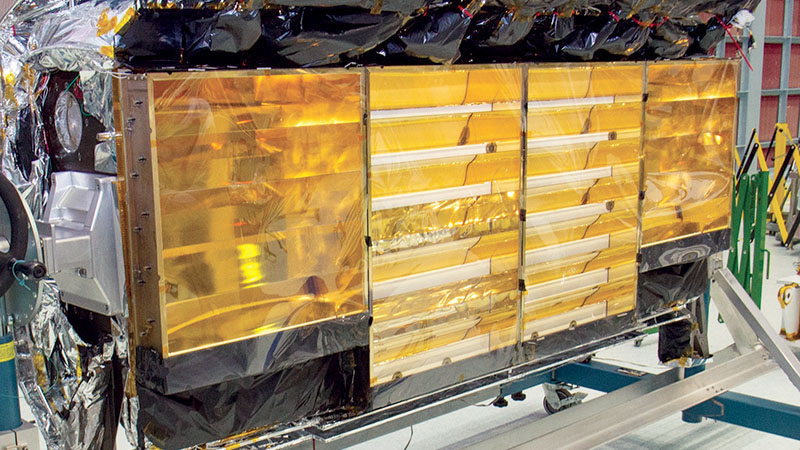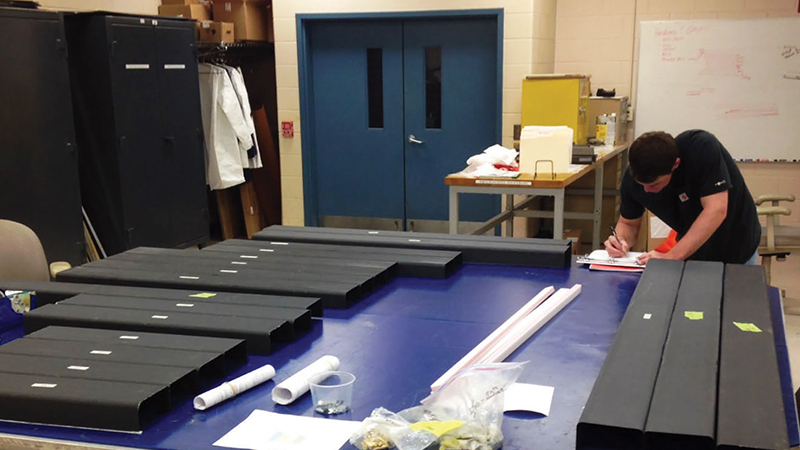Stay Up to Date
Submit your email address to receive the latest industry and Aerospace America news.
An academic and a businessman describe how they assembled a team of students and professionals to make components for NASA’s $8 billion James Webb Space Telescope.
One day in 2008, Rick Krontz, then an aircraft-structures instructor at Middle Georgia College, stopped by Neptune Precision Composites in Jacksonville, Florida. It was a routine check-in about a technical student the company hired. Krontz struck up a conversation with Frank Huber, a composites engineer at Neptune. Huber had an inspiration when he heard about the school’s fabrication facility and students. He introduced Krontz to Robert Rashford, whose company Genesis Engineering Solutions was known for making flight hardware for the Hubble Space Telescope. Aerospace America invited Krontz and Rashford to describe how they assembled a team of students and professionals to make components for NASA’s $8 billion James Webb Space Telescope.
In 2008, composites engineer Frank Huber suggested to us that the missions of Middle Georgia College (now Middle Georgia State University) and Genesis Engineering Solutions might mesh well. At the time, Middle Georgia trained aircraft structural technicians and Genesis made tools and parts for NASA’s Hubble Space Telescope servicing missions. Huber was right.
What emerged was a partnership that helped each of our organizations grow while giving hands-on manufacturing experience to dozens of students. This was not just any experience, but experience building critical components of the James Webb Space Telescope scheduled for launch in 2018.
We realized quickly that Middle Georgia State had manufacturing resources capable of accommodating complex structures, and Genesis had experience with space structures, having helped NASA with Hubble. By teaming with Genesis, we won a contract from NASA’s Goddard Space Flight Center to build the telescope’s Integrated Science Instruments Module Electronics Compartment, or IEC for short, and also a backplane support fixture, the structure that holds the primary mirror. This backplane was for the second round of thermal testing, called Core 2. To orient you, the IEC is located in Region 2 of Webb’s blueprint, an area on the shaded cryogenic side of the telescope’s sunshield. From this side, the telescope’s segmented mirror will look out to the cold of space to gather infrared radiation from the early universe, our galaxy and planets beyond our solar system. Additional mirrors will direct that radiation into the Integrated Science Instruments Module, or ISIM, which houses the four scientific instruments. Mounted to this module is the ISIM Electronics Compartment, or IEC, which our team built.
The IEC is a composite structure that houses 13 electronics boxes,including those that will control the mechanisms that must unfurl, unfold and erect the Webb telescope in space after its launch; plus the computer that will align the mirror’s segments and steer the secondary mirrors to direct photons into an optical path leading to the four science instruments; and the electronics that will convert those photons into signals that will be read by computers on Earth.
The design of the IEC was complex because of the thermal challenges aboard Webb. The electronics in the IEC must be kept at 80 degrees Fahrenheit (300 kelvins) to operate properly, but the equipment outside the enclosure must stay at minus 400 degrees Fahrenheit (33 kelvins) to maximize the telescope’s sensitivity to infrared radiation. The thermal task was akin to putting a freshly roasted chicken into a freezer, and keeping the chicken warm without letting it melt the surrounding ice. To do that, you would have to put the chicken, or the electronics in our case, inside a protective enclosure, but one that lets excess heat escape the freezer without reaching the ice.
That’s the IEC. Inside, sets of electronics are attached to four composite panels whose job is to capture heat from the electronics. This heat must be steered out of the IEC and away from the instruments, so on one wall we installed four baffles consisting of graphite composite louvers covered with vapor-deposited 14-karat gold. Graphite lay-up material was chosen because of its low coefficient of thermal expansion, which means it’s very stable. The gold coating has the desired thermal emissivity for removing heat quickly. Each baffle is attached to a 2.5-centimeter-thick radiator panel. Together, the radiators and baffles direct heat out to space safely.
To build the IEC and the Core 2 backplane support fixture, Middle Georgia established a student internship program under which participants worked up to 20 hours a week. Other students at times participated from their classrooms. Specifically, students helped build the louvers and the primary ICE structure using computer-aided-design data and approved written work instructions and guidance from Genesis staff. The students interpreted the CAD data; created two-dimensional cut programs to trim the carbon and fiberglass materials on a computer-numerical-control, or CNC, cutting table. They also operated CNC routers and milling machines to make small molds and tooling aids. They helped create written instructions and quality control programs. Students kept track of pertinent information such as batch and lot numbers, expiration dates and quantity. They were required to work within high tolerances and an aggressive schedule. They prepared composite lay-up molds; hand-laid materials; vacuum bagged, leak checked, cured, cut and trimmed composite parts.
NASA accepted the idea of students participating in the manufacturing because of the precautions each of us took. Genesis ultimately is responsible for our contract and the hardware that gets delivered. NASA trusted Genesis, because of our record of on-time and on-budget delivery for Hubble. Our team also walked NASA’s quality control and assurance expert through the process of how we were going to manufacture the components.
For Middle Georgia, the program was a great way to stay proficient and current in aerospace technologies. The work also caught the eye of Georgia’s Center of Innovation for Aerospace, which helped the school forge a partnership with Area I, a drone startup in Kennesaw. For students, the program was an invaluable opportunity to work in real-world, intense, hands-on project. Some students decided to pursue engineering degrees because of their experiences. Others decided to become entrepreneurs. All went on to be employed in some fashion in the aerospace industry, applying a multitude of skills for major aviation or space employers.
When the IEC was completed, we packed the components into an air-cushioned truck and drove the parts to our facility in Lanham, Maryland, for assembly. We delivered the IEC in 2014 on time and within budget. For that reason, NASA asked our team to build two more IECs to support system level testing. Today, we have one flight replica at NASA’s Johnson Space Center in Texas and one at NASA’s Goddard Space Flight Center in Maryland. They are used for quantifying the rate at which heat is radiated out of the IEC. Maintaining the right temperature is critical for the health of the electronics. Unlike Hubble, Webb will be too far from Earth for NASA to send astronauts to service it.
Today, technicians and engineers in a variety of organizations acquired critical skills because of this program. They will be watching as closely as anyone in 2018 when the telescope lifts off aboard its Ariane 5 rocket. ★
"NASA accepted the idea of students participating in the manufacturing because of the precautions each of us took. Genesis ultimately is responsible for our contract and the hardware that gets delivered."
Robert Rashford, founder of Genesis Engineering Solutions, and Rick Krontz, former director of the Institute for Applied Aerospace Research
Related Posts
Stay Up to Date
Submit your email address to receive the latest industry and Aerospace America news.






